The People's Bank of China shocked market players Thursday by announcing an interest rate increase after markets had closed in Asia. It was the PBOC's first change in monetary policy in 18 months. The Bank said it was doing so to head off overheating and massive overinvestment in its economy caused by runaway growth in bank loans. The PBOC's benchmark one-year lending rate was increased by 27 basis points to 5.85 percent, up from 5.58 percent. Deposit rates remain unchanged. The move instantly hit global stock markets by raising fears that China's growth could stall and dull its ravenous appetite for imports. Shares in European mining, utility and oil companies all sank.
The move was probably more symbolic rather than one that could actually slow an economy that is roaring along, at a 10.2 percent GDP growth rate in the first quarter when compared with last year. But the move reflects growing concern among China's top leaders about economic overheating. Analysts expect that the PBOC might increase interest rates again as well as take other steps such as setting aside more reserves.
China's interest rate move vied with Fed Chairman Ben Bernanke's testimony before the Joint Economic Committee to influence global markets. In effect they counter-balanced each other. While PBOC's move sent a shudder through commodity and stock markets as it raised fears of lower demand and slower economic growth, later comments from Bernanke about the U.S. interest rate outlook proved generally soothing as he hinted there could be a pause in monetary tightening. Bernanke's sanguine testimony proved a positive surprise for many analysts. His comments put downward pressures on the already weakened dollar, which fell to a new seven-month low against the euro and to a three-month low against the yen.
On the week, nine of 13 stock indexes followed here were down. And for the month of April, four indexes declined while the remaining nine were up. All indexes are positive so far in 2006.
Global Stock Market Recap

Europe and the UK
The last week was not kind to European stockholders. After peaking early in the week, all three indexes crumbled after they were buffeted by crude oil price fluctuations, profit taking, earnings 'disappointments' and world interest rate prospects. Regarding earnings, one has to ask if they truly disappointed or if expectations were unduly exuberant. After soaring over $75 a barrel, crude prices edged downward and so did energy company stocks. Investors were concerned that slightly lower prices could injure earnings prospects. Then on Thursday, China unexpectedly raised its benchmark interest, joining Europe and the U.S. in increasing borrowing costs. Stocks tumbled in Europe in response - financial markets were already closed in Asia and the Pacific.

Despite being down on the week, both the FTSE and DAX gained in April. The FTSE was up 1 percent while the DAX increased by 0.7 percent. The CAC was down 0.6 percent for the month.
Asia/Pacific
Although a day passed before Asian/Pacific indexes could react to the move by the PBOC, only the STI managed to have a positive day on Friday. And only the STI and all ordinaries were barely positive for the week. But losses in the last week of April pulled down the results for the month for the remaining stock indexes followed here. The two Japanese indexes - the Nikkei and Topix - were down on the week and the month. The Nikkei lost 2.9 percent on the week and was down 0.9 percent on the month while the Topix was not hit quite as hard. It lost 2.3 percent last week and 0.7 percent in April. The Hang Seng and Kospi were down 1.5 percent and 2.2 percent respectively on the week. But despite those losses the indexes gained 5.4 percent and 4.4 percent respectively in April.

Bank of Japan still on hold
The Bank of Japan held a one day meeting on Friday (no policy change) after which they released their economic forecast for the economy. The Bank forecast a steady turn to price stability, with an expected increase in the core consumer price index of 0.6 percent this fiscal year (ending March 31, 2007) and 0.8 in the following fiscal year. For the same time frame, the BoJ expects GDP to expand 2.4 percent and 2 percent. On Friday, economy minister Kaoru Yosano became the first minister in many years to warn of the inflationary dangers saying price increases could become problematic over the next six months to a year. However, other cabinet members including interior minister Heizo Takenaka continue to insist that Japan is caught in a mild deflation.
A split has emerged between policymakers and economists. Some believe deflation needs to be thoroughly trounced even at the risk of allowing a little bit of inflation to take hold while others argue that the risk has now shifted from deflation to inflation, and that the central bank needs to be vigilant against the emergence of inflation.
The BoJ has been trying to calm market expectations of aggressive rate increases saying that the accommodative financial conditions ensuing from very low interest rates will be maintained for some time.
North America
Canadian interest rates continue on upward path
Bank of Canada increased their policy interest rate by 25 basis points to 4 percent Tuesday. This was the Bank's sixth straight 25 basis point increase. The Bank indicated that more increases are in store in order to keep aggregate supply and demand in balance and inflation on target. The Bank's inflation target range is one to three percent, focusing at the two percent midpoint. Despite the Canadian dollar's appreciation, there is little sign that it has slowed the economy very much as demand for commodities stretches those industries to full capacity. The spread between U.S. and Canadian interest rates is 75 basis points - at least until the FOMC meeting on May 10th when the fed funds rate is expected to climb to 5 percent.

In its latest Monetary Policy Report, the Bank of Canada raised its 2007 economic growth forecast a tenth to 3 percent and kept the 2006 forecast at 3.1 percent. In its statement, the Bank said that the rising Canadian dollar and foreign competition "continue to pose challenges for a number of sectors of the economy." A higher currency makes exported goods more expensive for purchasers. The Canadian dollar is at its strongest since November 1991.
North American stocks
Only the Nasdaq of the four indexes followed here declined in April - it was down 0.7 percent. The S&P/TSX composite scored well in April - up 0.8 percent - despite the index's bumpy ride as crude oil and other commodity prices fluctuated. The Dow was up a healthy 2.3 percent in April, its best monthly performance in 2006. But the winner was the Bolsa - it was up a rousing 7.1 percent in April.

Currencies
Traders rushed to sell the dollar after Fed Chairman Bernanke said the Bank might stop increasing rates "at some point" after 15 straight increases. This added to traders' concern that the U.S. interest rate advantage may diminish relative to Japan and Europe. The dollar already has dropped on speculation that the interest rate spread between Japan and Europe would narrow - sometime in the future. Since the beginning of 2006, the dollar has declined about 3.5 percent against the yen and 6.7 percent against the euro.

The dollar had staged a brief rebound earlier in the week after Japan's top currency official said investors misinterpreted the Group of Seven nations' call last week for Asian countries to allow their currencies to strengthen. The G-7 statement didn't say that the dollar should fall in value according to Hiroshi Watanabe, vice finance minister for international affairs. Japan has been known to vigorously intervene in the currency markets in the past, although it has not done so for over two years. A weaker yen benefits the country's exports and its flow of profits.
Indicator scoreboard
EMU - February seasonally adjusted merchandise trade deficit was €2.7 billion. On a non-seasonally adjusted basis, the deficit was €3.1 billion. Exports were up 4.3 percent while imports edged down 2.1 percent. On the year, exports were up 14 percent and imports were up 22 percent thanks to energy.

February seasonally adjusted current account deficit widened to €5.6 billion from €0.7 billion in January. The data reflect a current transfer deficit which was only partially offset by the services surplus.
February industrial production was unchanged and up 3.2 percent when compared with last year. Nondurable consumer goods output was up 0.7 percent while capital goods were up 0.5 percent. These gains were offset by a decline in consumer durables of 0.5 percent and in intermediate goods of 0.7 percent.

M3 money supply for the three months ending in March soared by 8.1 percent when compared with the same three months a year earlier. For March alone, M3 was up 8.6 percent on the year. Private loan growth was up a robust 10.8 percent on the year. The ECB's target rate of growth is 4.5 percent for the three-month moving average.

April flash harmonized index of consumer prices jumped 2.4 percent when compared with last year. No details are provided with flash reports. This is uncomfortably above the ECB's 2 percent inflation ceiling.

EU - April economic sentiment index reading climbed to 105.3 from March's reading of 103.6. Both industrial and consumer confidence improved. Industrial confidence improved to plus 1 from minus 1 while consumer confidence improved to minus 10 from minus 11. Services sentiment was up to 18 from March's reading of 15. Retail and construction sentiment were unchanged at minus 1 and minus 3 respectively.

Germany - February industrial production was up 1 percent and 6.6 percent when compared with last year. All major groups gained with the exception of consumer durables which were down 0.8 percent. The strongest performance was by capital goods - up 1.5 percent on the month.

April Ifo business sentiment index climbed to 105.9 from 105.4 in March. Current conditions improved while business expectations were relatively unchanged. While both construction and wholesales showed an improved current climate reading, retailing was down on a more cautious view of the current situation.

April unemployment rate edged downward to 11.3 percent from 11.4 percent in March. In the East, the unemployment rate declined to 17.9 percent from 18.1 percent while in the West, the rate crept down to 9.6 percent from 9.7 percent.

March total retail sales plummeted 3.2 percent and were down 3.1 percent when compared with last year. Excluding autos and petrol stations, sales sank 2.7 percent. Both the Federal Statistical Office and Bundesbank, issuers of the data, said that these numbers would be revised upward.

France - March unemployment rate edged down to 9.5 percent from 9.6 percent in December, January and February. The number of unemployed was down by 30,000. The national employment agency ANPE, which counts jobseekers working less than 78 hours per month, registered a decline of 30,900.
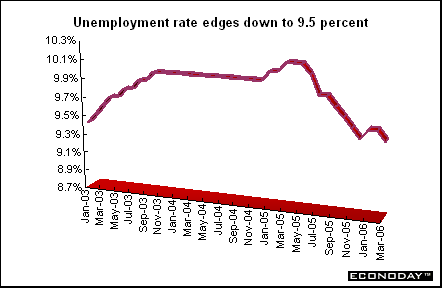
March producer price index was up 0.4 percent and 3.3 percent when compared with last year. Excluding food and energy, the PPI was up 0.2 percent and 1.3 percent on the year. Energy prices were up 0.6 percent and 11.2 percent on the year. Food and agriculture prices were up 0.5 percent and 2.1 percent on the year.

Italy - March producer price index was up 0.6 percent and 4.5 percent when compared with last year. Excluding energy, the PPI was up 0.5 percent and 1.7 percent on the year. Energy goods prices were up 17.5 percent on the year. Refined petroleum product prices were up 2.9 percent on the month while metals and metal products prices were up 1.3 percent.
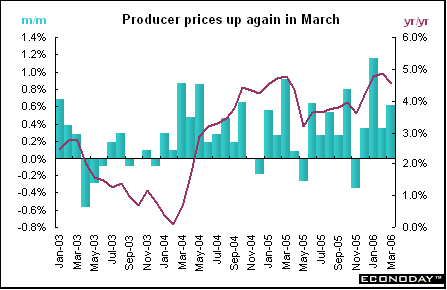
Britain - March retail sales were up 0.7 percent and 2.6 percent when compared with last year. The increase in sales was led by food, household goods and sales at department stores. Sales at mainly food stores rose 0.4 percent while sales at non-food stores also gained 0.4 percent, with sales at department stores increasing 3 percent. Non-store sales, such as mail-order and internet sales, were up more than 5 percent.
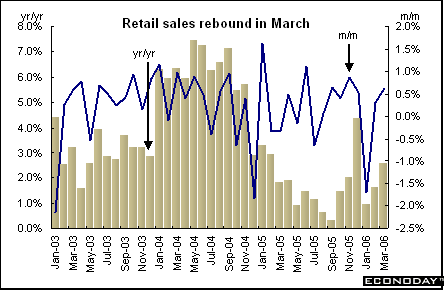
Preliminary first quarter gross domestic product was up 0.6 percent and 2.2 percent when compared with last year. All sectors were up on the quarter. Services output was up 0.6 while industrial output was up 0.7 percent thanks to a 0.5 percent increase in manufacturing output. In services, transport, storage & communications along with business services & finance were both up 0.9 percent.
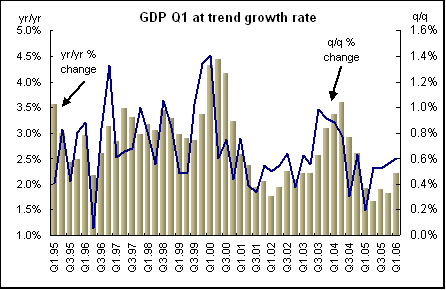
Asia
Japan - March unemployment rate was 4.1 percent for the second month. Employment was up 480,000 while unemployment dropped 240,000 indicating the country's labor market conditions are improving.

April Tokyo consumer price index was up 0.4 percent and 0.3 percent when compared with last year. The Core Tokyo CPI was up 0.3 percent and 0.3 percent on the year. March national CPI was up 0.2 percent and 0.3 percent on the year. Core CPI was up 0.3 percent and 0.5 percent on the year. Prices fell for food and housing.

March industrial production was up 0.2 percent and 3.1 percent when compared with last year. This was the first increase in 2006. Transport equipment, electronic parts & devices, pulp, paper & paper products contributed to the increase.

March retail sales were up 18.1 percent and 1 percent when compared with last year. Sales at large-scale retailers fell 0.6 percent on the year in March, after adjustment for the change in the number of stores.
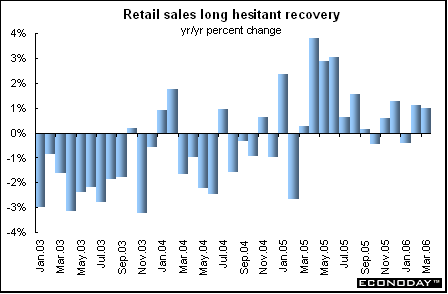
March real workers household spending sank 2.1 percent from a year earlier. The propensity for wage earner households to consume, a ratio which measures the amount of disposable income that went to household spending, rose 1.2 percent on the year. Household spending is an important gauge of personal consumption, which accounts for roughly 55 percent of gross domestic product. The spending data now include agricultural, forestry and fishery workers. The original series that excluded these workers is now available about 2 weeks later and only in Japanese.
Australia - First quarter producer price index was up 0.8 percent and 3.8 percent when compared with the same quarter a year ago. The domestic component of the index was up 0.7 percent mainly due to price increases in building construction, services to transport and other agriculture. These increases were partially offset by decreases in motor vehicle and parts manufacturing. The imports component was up 0.8 percent primarily due to price increases for consumption goods, including other manufacturing and petroleum refining. Imports of capital goods declined 0.1 percent due to lower prices for electronic equipment, which were partially offset by higher prices for industrial machinery.
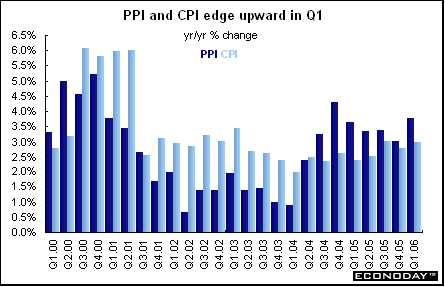
First quarter consumer price index was up 0.9 percent and 3 percent when compared with the same quarter in 2005. Contributing most to the overall increase were pharmaceuticals, up 14.2 percent; vegetables, up 7.9 percent; motor vehicles, up 1.4 percent; hospital and medical services, up 1.4 percent; as well as beer and tobacco, both up 1.4 percent. Among the price declines were deposit and loan facilities, down 2.1 percent; furniture, down 3.2 percent; clothing and footwear accessories, down 3.5 percent; and audio, visual & computing equipment down 1.5 percent.
Americas
Canada - February monthly gross domestic product was up 0.2 percent and 3.3 percent when compared with last year. Goods production inched up 0.1 percent after declining in January while services were up 0.3 percent, slightly less than the January pace. Utilities jumped by 4.7 percent after sinking 4.9 percent in January. However, mining dropped 2.1 percent. Construction and the financial sector were up 0.6 percent and 0.4 percent respectively.

Bottom line
The May round of central bank meetings begins this week with meetings of the Reserve Bank of Australia, Bank of England and the European Central Bank. Analysts think that the RBA is considering an increase from its current 5.5 percent level given the unexpectedly large increase in consumer prices during the first quarter. The Bank of England is not expected to change its key interest rate from 4.5 percent at this meeting although the next move is expected to be an increase. ECB Governor Jean Claude Trichet went to great lengths after the April meeting to disabuse market players that a May increase was all but a fait accompli. So while analysts still think there are interest rate increases in the ECB's future, they are less sure of when they will occur.

